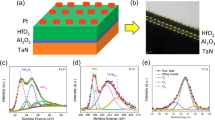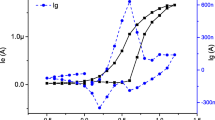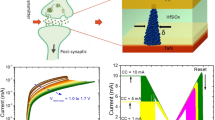Abstract
Emerging memristors can be used as artificial synapses for emulating memory and computational functions. In this work, inspired by the memristive properties of tantalum dioxide, we designed a memristor with a structure of TiN/Ta2O5−x/HfxZr1−xO2 (x=0.5)/Pt (TTHZOP). The device conductance can be continuously tuned by adjusting the voltage pulse parameters (i.e., amplitude, width, and number) of voltage sweeps. Furthermore, for both of negative and positive parts, the current-voltage curves of the sweep cycle appear to better adjust the gradual distribution in successive twenty cycles. According to the fine fitting results of twenty positive and negative current-voltage (I–V) curves, the probability of an electron jumping over an energy barrier and the width of the energy barrier were analyzed in detail. It is found that the electron tunneling mechanism at the interface is responsible for gradual conduction change under successive external electrical stimulation consisting of both bulk and interface effects. The proposed TTHZOP memristor is a promising candidate in potential applications that mimic artificial biosynaptic adaptation and analog brain computation.
摘要
新兴的忆阻器可以用作模拟记忆和计算功能的人工突触. 在这项工作中, 受钽氧化物记忆特性的启发, 我们设计了一种结构为TiN/Ta2O5−x/HfxZr1−xO2 (x=0.5)/Pt (TTHZOP)的忆阻器. 通过调整电压扫描的电压脉冲参数(即振幅、 脉宽和数量), 可以连续调节器件的电导. 此外, 对于正负两部分, 扫描周期的电流-电压(I-V)曲线在连续20个周期内似乎更好地调整了渐进分布. 根据20条正、 负IV曲线的精细拟合结果, 详细分析了电子跃迁势垒的概率和势垒宽度. 结果表明, 在连续的体效应和界面效应共同作用下, 界面处的电子隧穿机制导致导电性逐渐变化. 本文所提出的TTHZOP忆阻器在模拟人工生物突触适应和模拟脑计算方面具有潜在的应用价值.
Similar content being viewed by others
References
Zhao Q, Xie Z, Peng YP. Current status and prospects of memristors based on novel 2D materials. Mater Horiz, 2020, 7: 1495–1518
Yan X, Yin J, Guo HX, et al. Bipolar resistive switching performance of the nonvolatile memory cells based on (AgI)02(Ag2-MoO4)08 solid electrolyte films. J Appl Phys, 2009, 106: 054501
Alibart F, Gao L, Hoskins BD, et al. High precision tuning of state for memristive devices by adaptable variation-tolerant algorithm. Nanotechnology, 2012, 23: 075201
Chua L. Memristor: the missing circuit element. IEEE Trans Circuit Theor, 1971, 18: 507–519
Strukov DB, Snider GS, Stewart DR, et al. The missing memristor found. Nature, 2008, 453: 80–83
Yang JJ, Strukov DB, Stewart DR. Memristive devices for computing. Nat Nanotech, 2013, 8: 13–24
Tan ZH, Yang R, Terabe K, et al. Synaptic metaplasticity realized in oxide memristive devices. Adv Mater, 2016, 28: 377–384
Hasegawa T, Ohno T, Terabe K, et al. Learning abilities achieved by a single solid-state atomic switch. Adv Mater, 2010, 22: 1831–1834
Jo SH, Chang T, Ebong I, et al. Nanoscale memristor device as synapse in neuromorphic systems. Nano Lett, 2010, 10: 1297–1301
Guo R, Lin W, Yan X, et al. Ferroic tunnel junctions and their application in neuromorphic networks. Appl Phys Rev, 2020, 7: 011304
Wang Z, Joshi S, Savel’Ev SE, et al. Memristors with diffusive dynamics as synaptic emulators for neuromorphic computing. Nat Mater, 2017, 16: 101–108
Serb A, Bill J, Khiat A, et al. Unsupervised learning in probabilistic neural networks with multi-state metal-oxide memristive synapses. Nat Commun, 2016, 7: 12611
Berdan R, Vasilaki E, Khiat A, et al. Emulating short-term synaptic dynamics with memristive devices. Sci Rep, 2016, 6: 18639
Tuma T, Pantazi A, Le Gallo M, et al. Stochastic phase-change neurons. Nat Nanotech, 2016, 11: 693–699
Terabe K, Hasegawa T, Nakayama T, et al. Quantized conductance atomic switch. Nature, 2005, 433: 47–50
Waser R, Aono M. Nanoionics-based resistive switching memories. Nat Mater, 2007, 6: 833–840
Yan X, Zhang L, Chen H, et al. Graphene oxide quantum dots based memristors with progressive conduction tuning for artificial synaptic learning. Adv Funct Mater, 2018, 28: 1803728
Wedig A, Luebben M, Cho DY, et al. Nanoscale cation motion in TaOx, HfOx and TiOx memristive systems. Nat Nanotech, 2016, 11: 67–74
Li S, Barbera D, Vuillaume F. Filamentary switching: synaptic plasticity through device volatility. ACS Nano, 2015, 9: 941–949
Lim H, Kim I, Kim JS, et al. Short-term memory of TiO2-based electrochemical capacitors: empirical analysis with adoption of a sliding threshold. Nanotechnology, 2013, 24: 384005
Yan X, Zhao Q, Chen AP, et al. Vacancy-induced synaptic behavior in 2D WS2 nanosheet-based memristor for low-power neuromorphic computing. Small, 2019, 15: 1901423
Yu S, Wu Y, Jeyasingh R, et al. An electronic synapse device based on metal oxide resistive switching memory for neuromorphic computation. IEEE Trans Electron Devices, 2011, 58: 2729–2737
Kim S, Du C, Sheridan P, et al. Experimental demonstration of a second-order memristor and its ability to biorealistically implement synaptic plasticity. Nano Lett, 2015, 15: 2203–2211
Indiveri G, Linares-Barranco B, Legenstein R, et al. Integration of nanoscale memristor synapses in neuromorphic computing architectures. Nanotechnology, 2013, 24: 384010
Li Y, Zhong Y, Zhang J, et al. Activity-dependent synaptic plasticity of a chalcogenide electronic synapse for neuromorphic systems. Sci Rep, 2014, 4: 4906
Ascoli A, Tetzlaff R, Chua L. Robust simulation of a TaO memristor model. Radioengineering, 2015, 24: 384–392
Miao F, Yi W, Goldfarb I, et al. Continuous electrical tuning of the chemical composition of TaOx-based memristors. ACS Nano, 2012, 6: 2312–2318
Hur JH, Lee MJ, Lee CB, et al. Modeling for bipolar resistive memory switching in transition-metal oxides. Phys Rev B, 2010, 82: 155321
Lee MJ, Lee CB, Lee D, et al. A fast, high-endurance and scalable non-volatile memory device made from asymmetric Ta2O5−x/TaO2−x bilayer structures. Nat Mater, 2011, 10: 625–630
Yoon JH, Song SJ, Yoo IH, et al. Highly uniform, electroforming-free, and self-rectifying resistive memory in the Pt/Ta2O5/HfO2−x/TiN structure. Adv Funct Mater, 2014, 24: 5086–5095
Yoong HY, Wu H, Zhao J, et al. Epitaxial ferroelectric Hf0.5Zr0.5O2 thin films and their implementations in memristors for brain-inspired computing. Adv Funct Mater, 2018, 28: 1806037
Fan Z, Deng J, Wang J, et al. Ferroelectricity emerging in strained (111)-textured ZrO2 thin films. Appl Phys Lett, 2016, 108: 012906
Yi W, Savel’Ev SE, Medeiros-Ribeiro G, et al. Quantized conductance coincides with state instability and excess noise in tantalum oxide memristors. Nat Commun, 2016, 7: 11142
Zhang JJ, Sun HJ, Li Y, et al. AgInSbTe memristor with gradual resistance tuning. Appl Phys Lett, 2013, 102: 183513
Gong N, Idé T, Kim S, et al. Signal and noise extraction from analog memory elements for neuromorphic computing. Nat Commun, 2018, 9: 2102
Dayan P, Abbott L. Theoretical Neuroscience: Computational and Mathematical Modeling of Neural Systems. Cambridge: MIT Press, 2001
Bell CC, Han VZ, Sugawara Y, et al. Synaptic plasticity in a cerebellum-like structure depends on temporal order. Nature, 1997, 387: 278–281
Rodríguez-Moreno A, Paulsen O. Spike timing-dependent long-term depression requires presynaptic NMDA receptors. Nat Neurosci, 2008, 11: 744–745
Abbott LF, Nelson SB. Synaptic plasticity: taming the beast. Nat Neurosci, 2000, 3: 1178–1183
Zhang LI, Tao HW, Holt CE, et al. A critical window for cooperation and competition among developing retinotectal synapses. Nature, 1998, 395: 37–44
Yu S, Wong HSP. A phenomenological model for the reset mechanism of metal oxide RRAM. IEEE Electron Device Lett, 2010, 31: 1455–1457
Lu Y, Gao B, Fu Y, et al. A simplified model for resistive switching of oxide-based resistive random access memory devices. IEEE Electron Device Lett, 2012, 33: 306–308
Charlesby A. Ionic current and film growth of thin oxide layers on aluminium. Proc Phys Soc B, 1953, 66: 317–329
Sze SM. Semiconductor Devices: Physics and Technology. New York: John Wiley & Sons, 2008
Ivanov MV, Perevalov TV, Aliev VS, et al. Ab initio simulation of the electronic structure of δ-Ta2O5 with oxygen vacancy and comparison with experiment. J Exp Theor Phys, 2011, 112: 1035–1041
Khanuja M, Sharma H, Mehta BR, et al. XPS depth-profile of the suboxide distribution at the native oxide/Ta interface. J Electron Spectr Related Phenomena, 2009, 169: 41–45
Wang SJ, Ong CK. Epitaxial Y-stabilized ZrO2 films on silicon: dynamic growth process and interface structure. Appl Phys Lett, 2002, 80: 2541–2543
Espitia-Cabrera I, Orozco-Hernández H, Torres-Sánchez R, et al. Synthesis of nanostructured zirconia electrodeposited films on AISI 316L stainless steel and its behaviour in corrosion resistance assessment. Mater Lett, 2004, 58: 191–195
Kaufmann R, Klewe-Nebenius H, Moers H, et al. XPS studies of the thermal behaviour of passivated zircaloy-4 surfaces. Surf Interface Anal, 1988, 11: 502–509
Renault O, Samour D, Damlencourt JF, et al. HfO2/SiO2 interface chemistry studied by synchrotron radiation X-ray photoelectron spectroscopy. Appl Phys Lett, 2002, 81: 3627–3629
Jung HS, Kim YS, Kim JP, et al. Improved current performance of CMOSFETs with nitrogen incorporated HfO2-Al2O3 laminate gate dielectric. In: International Electron Devices Meeting. San Francisco: IEEE, 2002. 853–856
Xue KH, Blaise P, Fonseca LRC, et al. Prediction of semimetallic tetragonal Hf2O3 and Zr2O3 from first principles. Phys Rev Lett, 2013, 110: 065502
Kan-Hao Xue, Traore B, Blaise P, et al. A combined ab initio and experimental study on the nature of conductive filaments in Pt/HfO2/Pt resistive random access memory. IEEE Trans Electron Devices, 2014, 61: 1394–1402
Zhang J, Oganov AR, Li X, et al. Pressure-induced novel compounds in the Hf-O system from first-principles calculations. Phys Rev B, 2015, 92: 184104
Yan XB, Jia XL, Yang T, et al. Remarkable charge-trapping performance based in Zr0.5Hf0.5O2 with nanocrystal Ba0.6Sr0.4TiO3 blocking layer for nonvolatile memory device. Phys Lett A, 2016, 380: 3509–3513
Luna-Sánchez RM, González-Martínez I. Mobility degradation analysis for La2O3 nMOSFET. ECS Trans, 2006, 2: 329–338
Park J, Kwon DH, Park H, et al. Role of oxygen vacancies in resistive switching in Pt/Nb-doped SrTiO3. Appl Phys Lett, 2014, 105: 183103
Sun X, Li G, Chen L, et al. Bipolar resistance switching characteristics with opposite polarity of Au/SrTiO3/Ti memory cells. Nanoscale Res Lett, 2011, 6: 599
Acknowledgements
This work was supported by the National Natural Science Foundation of China (61674050 and 61874158), the Outstanding Youth Funding of Hebei University (A2018201231), the Support Program for the Top Young Talents of Hebei Province (70280011807), the Hundred Persons Plan of Hebei Province (E2018050004 and E2018050003) and the Supporting Plan for 100 Excellent Innovative Talents in Colleges and Universities of Hebei Province (SLRC2019018).
Author information
Authors and Affiliations
Contributions
Author contributions Zhang J developed the concept and conceived the experiments; Yang T drafted the manuscript; Wang J added the experimental data and revised the manuscript; Yan X drafted and revised the manuscript. All authors discussed and revised the manuscript.
Corresponding author
Additional information
Jing Zhang received her BSc degree from the School of Electronic and Information Engineering, Hebei University in 2018. She is currently a ME student in the University of Chinese Academy of Sciences. Her research interest is focused on the field of memristors
Tao Yang received his BSc degree from the School of Electronic and Information Engineering, Hebei University in 2017. He is currently a ME student in the University of Chinese Academy of Sciences. His research interests are focused on the fields of memristors and 3D-NAND flash memory
Jingjuan Wang received her BSc degree in communication engineering from the Department of Electronic Information Engineering, Tangshan University, China in 2016. She is currently a DE student at Hebei University Her current research interest is focused on the field of memristors
Xiaobing Yan is currently a professor at the School of Electronic and Information Engineering, Hebei University He received his PhD degree from Nanjing University in 2011. From 2014 to 2016, he held the Research Fellow position at the National University of Singapore. His current research interest is in the field of memristors.
Supplementary Information
40843_2020_1367_MOESM1_ESM.pdf
Memristive device with highly continuous conduction modulation and its underlying physical mechanism for electronic synapse application
Rights and permissions
About this article
Cite this article
Zhang, J., Yang, T., Wang, J. et al. Memristive device with highly continuous conduction modulation and its underlying physical mechanism for electronic synapse application. Sci. China Mater. 64, 179–188 (2021). https://doi.org/10.1007/s40843-020-1367-x
Received:
Accepted:
Published:
Issue Date:
DOI: https://doi.org/10.1007/s40843-020-1367-x




